| 1 | Japanese ratsnake |
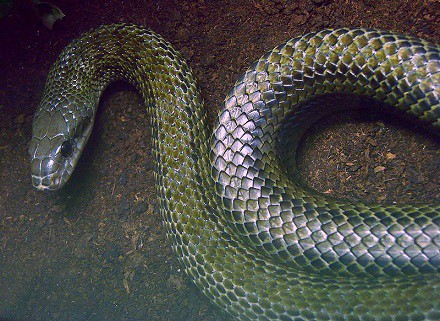
The longest snake on the Japanese mainland, at an average of 100 to 180cm, with an all-time record of 242cm. Japanese ratsnakes (Elaphe climaphora) are non-venomous, and prey mainly on warm-blooded creatures like mammals and nesting birds. However, they also have the ability to eat eggs, an ability they happily exploit.
The Japanese ratsnake slithers up to eggs in birds’ nests and seizes them with their fangs. The next step is 2 minutes of laborious rearranging, to ensure that the narrower end is pointing inwards. They then swallow the egg whole, and wriggle it to a spot approximately 6-8 inches below their mouth. At this point, the egg is still unfractured, but this is when the species’ specially modified spine comes into play. A Japanese ratsnake has vertebral shelves which are elongated, creating sharp hypapophyses, each of which is capped with enamel.
When the ratsnake contracts its body, with the egg still inside, these act as instant puncturing tools, causing the yolk and contents to leak while inside the snake’s belly. The ratsnake then enjoys all the vitamins, minerals and proteins within.
Japanese ratsnakes get faster at eating eggs with repetition; one study found that the first egg took 20 minutes to swallow, followed by 7 minutes thereafter. Young individuals lack the specially sharpened spine, meaning that it’s mainly adults which are the egg-swallowers. Japanese ratsnakes appear all over Japan, and can cope with most habitats.
| 2 | Taiwan kukri snake |
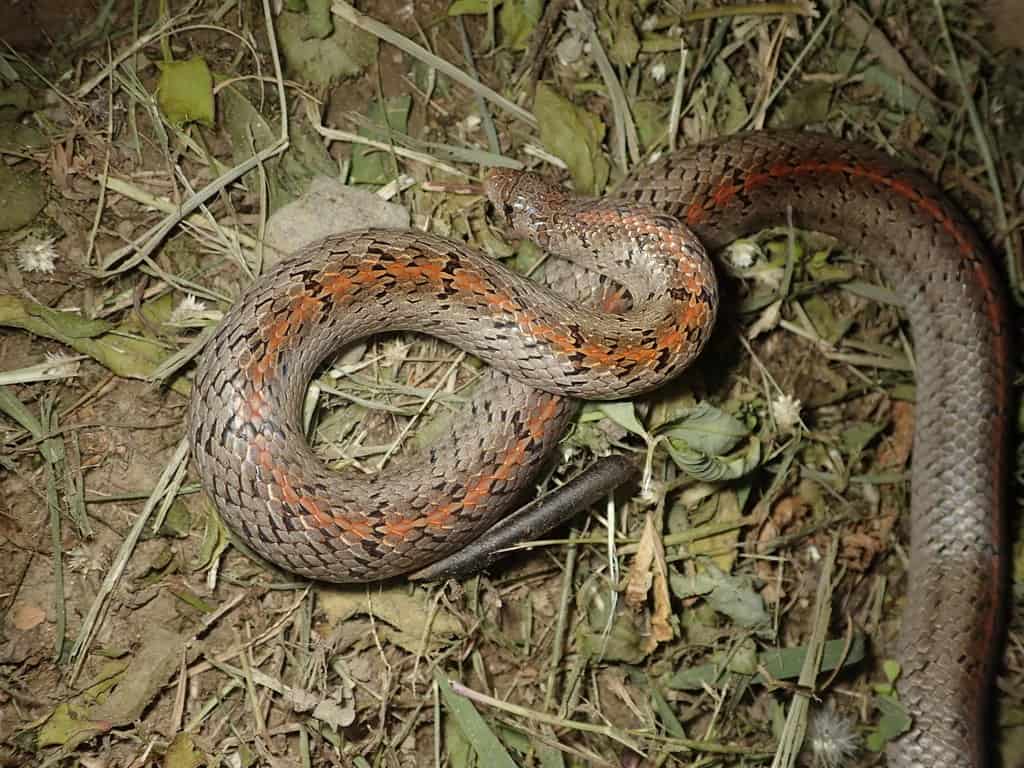
A resident of Taiwan, China and far southern Japan, which averages at just 50cm, with a maximum of 95cm. Taiwan kukri snakes are non-venomous, yet have infamously sharp fangs, which are more than capable of inflicting grisly wounds on a human being. Generally, this species will flee when they encounter a person, but picking one up can trigger a lightning storm of razor sharp, slashing bites.
These slashing tactics also come in use for their diet, which is rich in eggs. Rather than swallowing whole and crushing with an enlarged spine, Taiwan kukri snakes (Oligodon formosanus) do their work beforehand. Their maxillary teeth are brutally sharp and thin, and they use these to make repeated assaults on the eggs’ leathery surface. With persistence, the shell breaks, and the golden yolk begins to dribble out. The Taiwan kukri snake then thrusts its head inside the broken egg and slurps up the nutritious goo within. This species is able to displace its maxillary bone, allowing it to hold eggs in place and slash at the same time.
Being an egg lover, one of their favourite foods in captivity is chicken egg yolk, which they grab from the hands of keepers ravenously. In the wild, they eat many bird eggs, but particularly love eggs of the green sea turtle (Chelonia mydas).
| 3 | Argus goo eater |

This 40cm species (max 69cm) has two names: Argus goo eater or Argus snail sucker. The latter is because of their ability to suck slimy snails from their shells, but the former is because they love to scoop up orange frog spawn and swallow it.
Argus goo eaters live mainly in eastern Panama and southeastern Costa Rica. This is a jungle snake which lives on branches and large leaves, and next to small forest streams where their frog spawn dinner accumulates in large numbers. Their strategy is to wrap their tails around a tree branch, then dangle their heads down slowly to the lower branches. Here, they swallow up secret egg stashes laid in moss clumps or leaf undersides. They also slither directly along branches while finely balanced.
Argus goo eaters can be messy eaters, ending up with frog spawn all around their mouths like a baby needing a bib. Research is lacking, but they’re confirmed to eat the spawn of emerald glass frogs.
Rather than snails, frog spawn seems to be the main prey of Argus goo eaters. When chytid fungus infested the one region of Panama and decimated the native frog population by 75%, the local Argus goo-eaters also plummeted. Meanwhile, the more generalist eyelash viper was barely affected.
| 4 | Indian egg-eating snake |
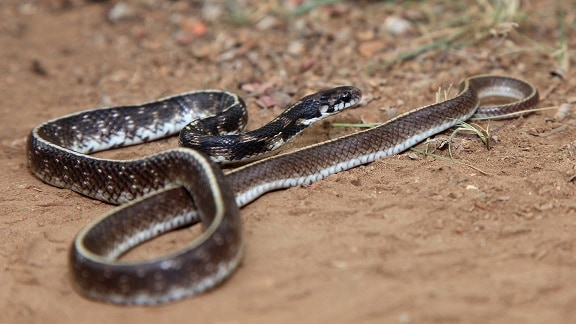
An Indian snake measuring 40-60cm (maximum 80cm), which mostly lives on the ground, but climbs thin vegetation with ease. This species is found mainly in western India, and is recognisable by the following features: large protruding eyes, a pale blue belly, and black scales contrasting sharply against a shining white spinal stripe.
Indian egg-eating snakes (Boiga westermanni) are hardly ever seen, but are believed to be common nevertheless. It’s their nocturnal habits and love of hiding in dark rock crevices which helps them to escape people’s eyes. Like the Japanese ratsnake, Indian egg-eating snakes swallow eggs whole and then crack them apart from within, using similar hypapophyses attached to their spinal column.
This eating process was observed in detail in 2014. A captive snake was gifted two blue rock pigeon eggs, which it greedily gobbled up. The snake squeezed the egg to its cervical region, but then stayed still for 3 minutes. Suddenly, it thrust its lower body downwards with massive force, cracking apart the egg inside with a single blow. Then it kept up the massaging pressure with a horizonal writhing motion, with each contraction lasting 2 seconds, in order to push the egg’s contents towards its stomach.
Finally, the snake regurgitated the shell. From swallowing the egg to spitting up the shell, the process took 56 minutes. With a weak venom at best, this species poses no threat to humanity, though eggs have a great deal to fear.
| 5 | Blanford’s bridle snake |
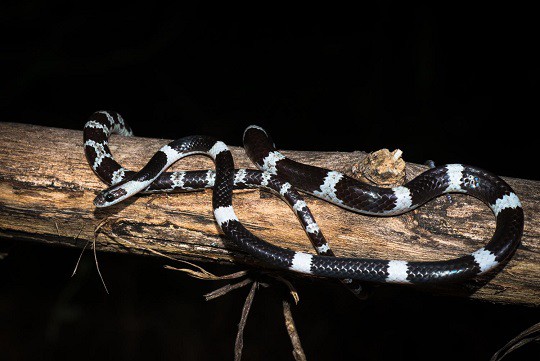
Blanford’s bridle snake is one of dozens of harmless snakes that quietly go about their business in the forests of southeast Asia without receiving an ounce of attention from mankind. It belongs to the same genus as the Indian wolf snake (Lycodon aulicus), and has been observed in almost all regions of Thailand, as well as Cambodia and Vietnam.
Blanford’s bridle snake (Lycodon davisonii) reaches up to 92cm, and was previously thought to eat geckos, but a 2020 study revealed that they ate bird eggs exclusively. These included eggs of the puff-throated bulbul, Abbott’s babbler, and white-rumped shama.
The study was a big one, covering 7 years (2013-2019), 23 different species, and 478 nests in total. Blanford’s bridal snake turned out to be the third most important bird nest predator of any animal, not just among snakes. The species accounted for 13% of nest raidings, and for certain species they particularly favour, the total was probably higher.
The bridal snakes spent an average of 81 minutes at each nest. They turned out to be strictly nocturnal, with only one snake spotted eating eggs before sunset. Blanford’s bridle snake was relatively flexible in its feeding style, as they usually swallowed the eggs whole, but sometimes carved openings in the shell and slurped out the insides.
| 6 | Central African egg-eating snake |
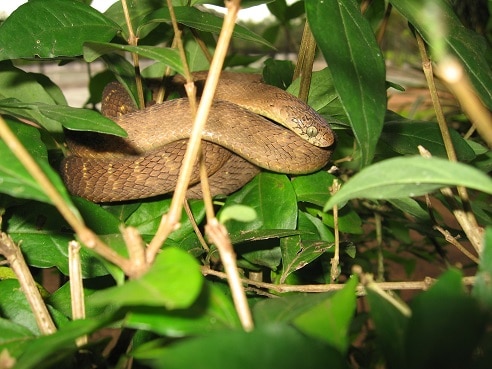
This might be the most extensively adapted egg-eating snake on Earth. The Central African egg-eating snake, AKA Dasypeltis fasciata, eats eggs exclusively. Like other Daspypeltis members, this is a tree-dwelling species. Its world consists entirely of branches – branches to sleep on, branches to use as pathways, branches where nests might be balanced.
Dasypeltis fasciata is a medium-sized snake, reaching a record of 102.1cm. They hunt at night, in order to take advantage of birds which leave their nests unguarded by day. They’re one of the egg-eating species which swallows them whole, before crushing them with specially sharpened vertebrae. But Dasypeltis fasciata goes beyond the Japanese ratsnake in having a particularly sharp sense of smell, allowing them to distinguish between a fresh egg and a rotten one which is too far gone.
They even have a specially adapted trachea, which allows them to roll a bowling ball-sized egg around their mouths and breathe comfortably at the same time. Their mouth is toothless, allowing the eggs easier access. The only trouble is that this reduces their ability to defend themselves. Instead, Dasypeltis fasciata uses Batesian mimicry, disguising itself as actually venomous snakes. This species is thriving in the wild, as they have very little competition for their staple food source.
| 7 | Black-collared snake |
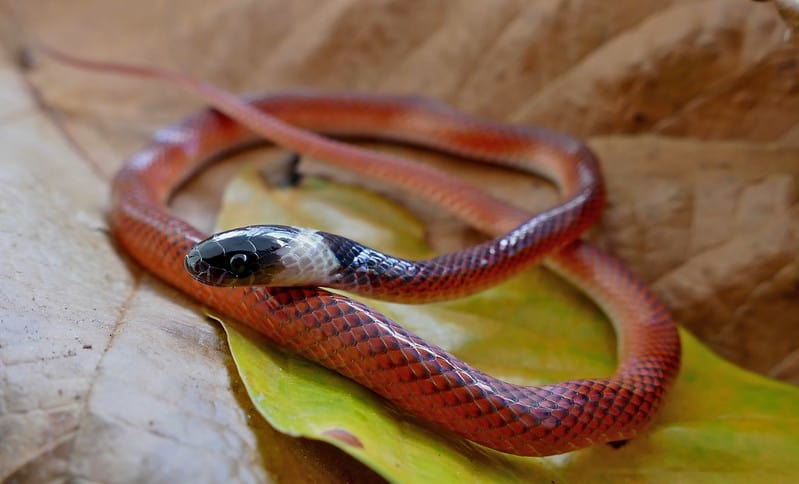
This Amazon rainforest snake is known to only a handful of Westerners, yet lives in a huge range in South America, from French Guiana to Peru to Bolivia. It’s the sole member of its Drepanoides genus, hence the Latin name of Drepanoides anomalus. A glance at a photo reveals a black collar, white belly, and coral red scales on its body. This is a semi tree-dwelling species which mainly lives in forests, and tends to flee if approached by humans, and only thrash violently if picked up.
The black-collared snake often falls victim to other snakes, including the dreaded Clelia clelia, and most of its own diet consists of lizard eggs. Research is thin, but eggs have been found in the stomachs of black-collared snakes from Peru, Ecuador, and Brazil.
One study reached a verdict of 70% lizard eggs, and the species also eats other snakes, including brown-banded watersnakes. Black-collared snakes are primarily ground dwelling, but climb vegetation with ease, and can sometimes reach 3 metres in the air. This species reaches a maximum length of 83.7cm.
| 8 | Scarlet snake |
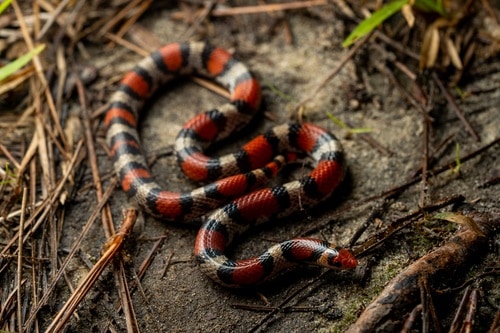
This 40-60cm Floridian snake is particularly obsessed with turtle eggs. Scarlet snakes reach a maximum of 82.3cm, and are completely non-venomous. They have brutally long front teeth, but rather than for attack, these are designed as a hacking tool to penetrate tough shells.
A scarlet snake’s first task to locate the turtle’s special egg-laying burrow. They then slither into the dark chamber (sometimes on a beach), and wrap around the first egg they see. With their coils tightly in place, the scarlet snake swings its head down to force its fangs deep into the shell. Without removing the fangs, the scarlet snake squeezes hard with its body, forcing the nutritious yolk and white into its open mouth. The loggerhead sea turtle is one species whose eggs they’re confirmed to hunt.
Scarlet snakes also devour eggs in captivity, taking great pleasure in their meal. Because of this diet, scarlet snakes have evolved longer front teeth than even some venomous snakes, including the pygmy rattlesnake. Fortunately, they never use these against people when picked up. Scarlet snakes are very shy, and mainly live in hardwood forests in the southeastern US, beneath a mixture of rotting logs and leaves.
| 9 | Eastern fox snake |
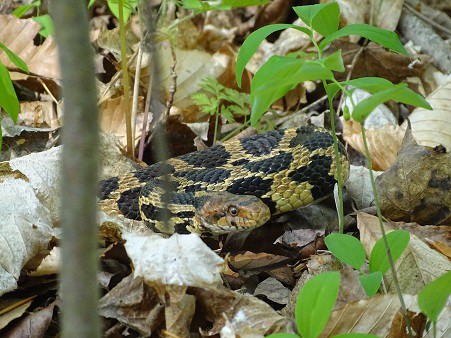
A semi-endangered species of the northeast USA and Canada. Eastern foxsnakes belong to the same Pantherophis genus as corn snakes, but have stricter habitat preferences. They dislike forests and heavy agriculture, and stick to dry open areas or marshland.
As for their diet, eastern foxsnakes consume a long list of bird eggs, including pheasant, duck, pigeon, and quail eggs. They particularly love sparrow eggs, including those of house sparrows, chipping sparrows, and song sparrows. The exact mechanism behind their egg crushing isn’t known, but they swallow them without any coils, and crush them somewhere in their long body (one old report said the throat).
Eastern foxsnakes like to frighten mother birds away from their nests, then dash in and swallow the eggs they’ve left behind. They also invade chicken coops, taking advantage of narrow gaps in cages and barns. After swallowing the egg, they later spit out the useless shell fragments. However, foxsnakes sometimes get a taste of their own medicine, as a 2011 report confirmed that American badgers eat their eggs. Eastern foxsnakes are larger than average, with a record length of 179.1cm.
| 10 | Puffing snake |
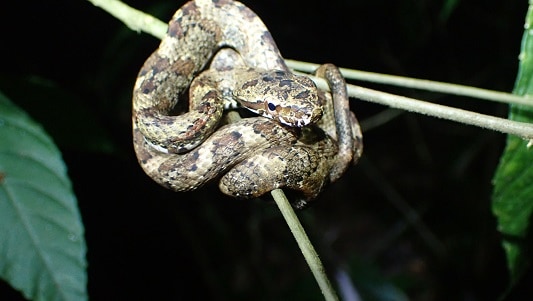
This Central and South American snake is non-venomous, but hisses loudly when confronted, before inflating its neck and delivering a sharp and painful bite. The puffing snake (Phrynonax poecilonotus) reaches a maximum of 2.4 metres, with an average of 1.5-1.8m, and ranges from southern Mexico to Ecuador, covering 11 countries. Locals have long spoken of its nest raiding habits, and science has recently confirmed it.
A 2005 study examined the nests of spotted antbirds and chestnut-backed antbirds in Panama, using strategically placed videocameras to accumulate dozens of hours of footage. 10 nests were raided for eggs, and of those, the puffing snake accounted for 8.
In 2015, a study ventured to Costa Rica, and again tested nests of the chestnut-backed antbird (they seem to love this family). This time, puffing snakes accounted for 37 of 46 egg thefts. This species is an egg-snatching extraordinaire.
Like the Japanese ratsnake, puffing snakes are crushers, using the common method of swallowing, then writhing to burst the egg while inside them. This species flexes its body from front to end, like a rope being tightened. When forcing the eggs further down their body, they move their snout from left to right.
One guy spotted a species of puffing snake (Phrynonax polylepis) raiding a great tinamou nest. This ground bird has bright turquoise eggs, and when the snake forced the whole egg into the core of its body, the neon colour was still visible through its scales. The two common species, P. polyepsis and P. poecilonotus, are closely related, and have many egg theft records to their name. Unlike some, puffing snakes eat both eggs and the recently hatched nestlings.
